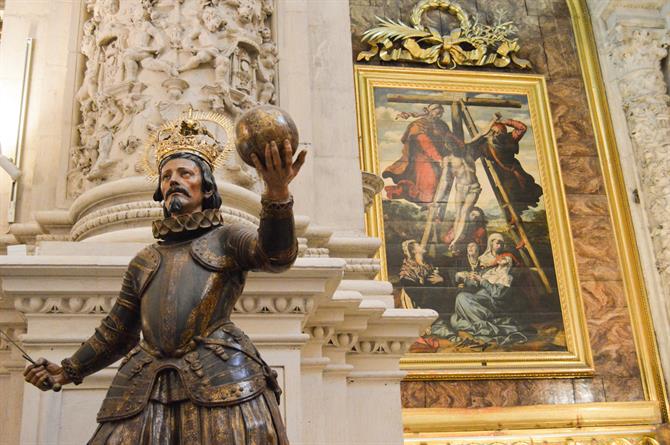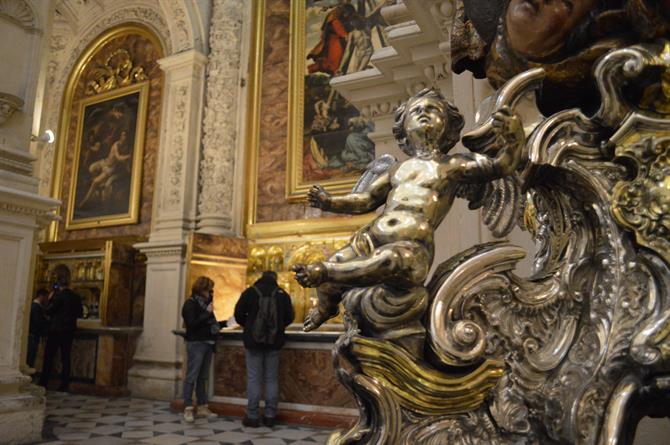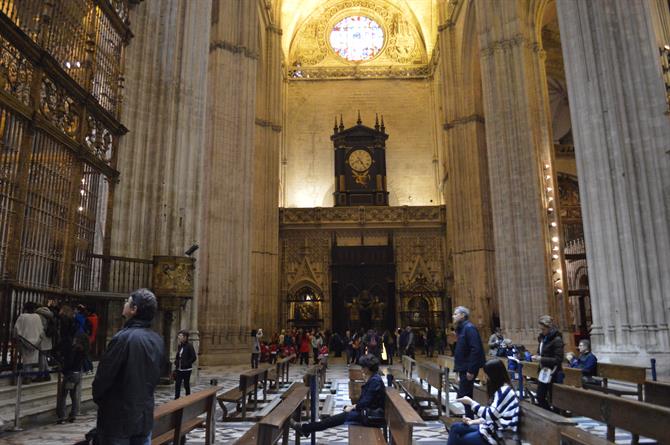The Cathedral of Seville is a Gothic wonder nesting within the heart of the Andalusian capital.
It commands the sky with its massive altarpiece and occupies approximately 11,520 square meters of land. Every inch of this striking site contributes to its haunting beauty.
When visiting this city, a trip to both the Seville Cathedral and the Giralda Bell Tower are necessary.
History of the Cathedral of Seville and the Giralda Bell Tower
Seville’s main mosque was constructed between the years 1184-1198, though its conversion to a Cathedral in 1248 would later lead to major reconstruction. These changes gave the Cathedral a dramatic, Gothic appearance that was largely characterized by its massive size.
Despite mass reconstruction, two parts of the original mosque were preserved: the Moorish entrance and the Giralda Bell Tower.
The Moorish entrance is defined by its ornate fountain, where worshippers would wash their hands and feet before their daily prayers. Preserved pieces of various religions contribute to the overall magnificence of this sight.
The splendour of the Cathedral is furthered by the influence of the Renaissance, where work in the Royal Chapel, the Main Sacristy, and the Chapter House was carried out.

In 1987, the Seville Cathedral was designated a UNESCO World Heritage Site.
Exploring around the Cathedral
The Cathedral and the Giralda Bell Tower are admirable both inside and out. To appreciate the face of the mighty Cathedral, view from Avenida de la Constitución.
If time allows, stroll around the Patio de los Naranjos once you leave the interior of the dimly-lit Cathedral. This area will be easy to find once you are within the walls of the palace.
For alternate views of the beautiful building, look at the Cathedral from the Plaza de los Reyes and up Mateos Gago Street into the Santa Cruz quarter.
Touring the Interior of the Cathedral
Enter the Cathedral from Alemanes Street through the Puerta del Perdón into the Patio de los Naranjos. The size alone will amaze, and the need for a visiting strategy will become apparent.
There are pamphlets available in many languages that propose detailed routes contingent on the length of your visit. These guides are a valuable resource as they ensure an efficient visit. We recommend taking one before submerging yourself in the vast Cathedral.

Stroll around and admire the incredible architecture, the large collection of artwork, and the otherworldly atmosphere. Not to be missed is the tomb of Christopher Columbus, the High Altar, and the golden Choir section.
Climbing the Giralda Bell Tower
From the entrance of the Cathedral, access to the Giralda Bell Tower can be found in the far right corner.
Climb thirty-four sloping ramps to reach the top where you will be rewarded with stunning views across Seville.
We suggest wearing a comfortable pair of walking shoes when exploring this site. Worth noting is the absence of stairs: ramps exist instead because they were used to accommodating the horses that would ascend the mosque five times a day for the call to prayer.
During the spring and summer months, this climb can be complicated by the steady flow of visitors ascending and descending the tower. Be mindful of this traffic when planning.
Getting to the Cathedral
Marking the beginning of the Santa Cruz district, the Cathedral is located along the Avenida de la Constitución.
If arriving by vehicle, the best option for parking downtown is in the Santa Cruz area (Parking Cano y Cueto) which has an entrance on Avendia Menendez Pelayo. It cost 1,45 € per hour and has roughly 351 parking spaces.
If you are travelling south from Plaza Nueva, the tram is another option. It has four stops that pass along Avenida de la Constitucion past the Cathedral. Officially called Metro-Centro, it runs from 6:00 to 1:30 with tickets costing 1.20 € at any station, machine, or on the tram itself.
Public transit is also an option, though not the most efficient. Most buses leave either from Puerta de Jerez (south of the center) or from Plaza Ponce de Leon (east). The circular buses, C3 and C4, follow the ring road around the old city center. One small bus takes a circular route inside the centre, the C5. They run from about 6:00 to 23:00, with night buses leaving from the Prado from 24:00 to 2:00. Tickets cost 1.40 € per trip, bought on-board.
The best way to get around Seville is on foot. There are signs everywhere in the city that direct visitors back to this central location. Otherwise, ask around and anyone who has spent time in the city will be able to guide you to the Cathedral.
Organizing Your Visit
Visiting hours during the winter season (September-May) are Monday to Friday from 11:00 to 17:00. During the summer, these hours are changed from 9:30 to 16:00. On Sundays, visiting is available from 14:30 to 18:00.
A thorough visit of both the Cathedral and the Giralda Bell Tower would take approximately ninety minutes.

General admission is 8 €, with a reduced fee of 4 € available for students and elders. This includes access to the Cathedral, the Giralda Bell Tower, and Iglesia San Salvador in Plaza del Salavador.
Despite their incredible size, the Seville Cathedral and the Giralda Bell Tower are only a small part of the enormous beauty of Seville. Amazing food, incredible sights, and a complex history all contribute to the unshakeable appeal of this Spanish city.
